The old Amoeba Records building on Sunset Boulevard will soon be knocked down to make room for a 26-story apartment tower. For now, though, the iconic building is playing host to The Immersive Van Gogh Exhibit. It’s a dazzling spectacle in more ways than one, a seizing of the senses that complicates questions of class, aesthetics, and entertainment, as well as the question of what may constitute a “museum.”
The burgeoning global phenomenon of “immersive art experiences” is not as new it may seem. The first was held in 1975, with photographer Albert Plécy’s “Cathédrale d’Images”—a technique that bathed viewers in gigantic projections on the walls of a massive abandoned quarry in Les Baux-de-Provence. Annual exhibitions of a similar kind still take place there under the name Carrières des Lumières, which held a Van Gogh exhibit in 2012.
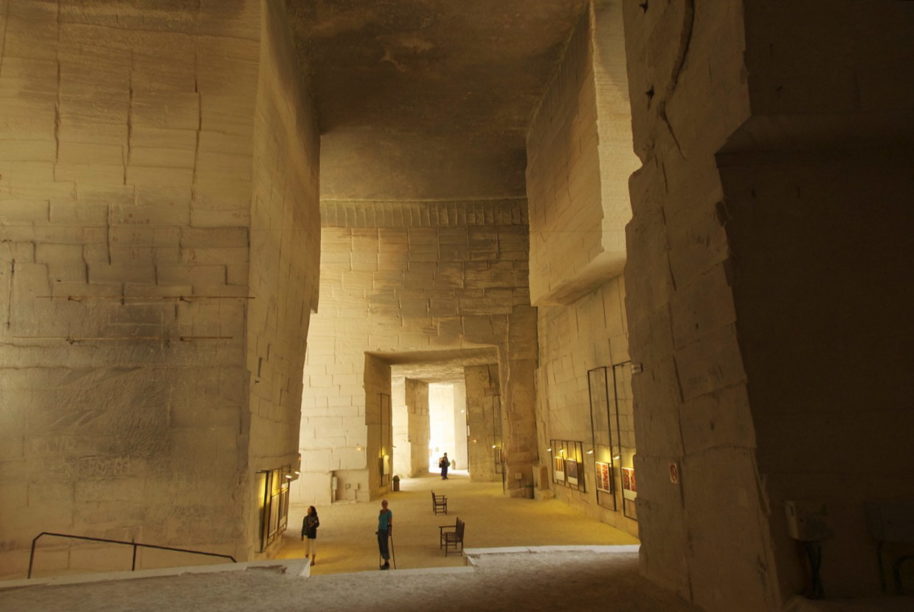 Hans Plantinga [CC BY-SA 3.0] via Wikimedia Commons
Hans Plantinga [CC BY-SA 3.0] via Wikimedia CommonsThe model has traveled all over the world, and grew popular by drawing on the works of a multitude of artists—plunging viewers into the dreamy, sensual realms of Claude Monet’s waterlilies, haystacks and Japanese bridges, and Gustav Klimt’s voluptuously shimmering golden tapestries. Now it’s Van Gogh’s turn to travel the globe in the “immersive” form. There are currently no fewer than five touring immersive experiences dedicated to his work, appearing all over Europe, the Americas and the Middle East. Ticket sales have numbered in the hundreds of thousands.
Amoeba Records, opened in 2001, was a Hollywood landmark, a southern California outpost of the famed Bay Area indie record shops. Offering at its peak over 250,000 titles, the Hollywood Amoeba was one of the largest independent music stores in the world. But Hollywood real estate prices soared irresistibly, and Amoeba sold the site in 2015 to developer GPI Companies with a five-year lease that meant a guaranteed relocation. Early in the pandemic, the store moved to new digs about a mile east, at the corner of Hollywood and Argyle. Los Angeles emerged from the pandemic lockdown to find our cultural landscape startlingly rearranged. The loss of our beloved Cinerama Dome was bad enough; now we get whiplash trying to remember where Amoeba went.
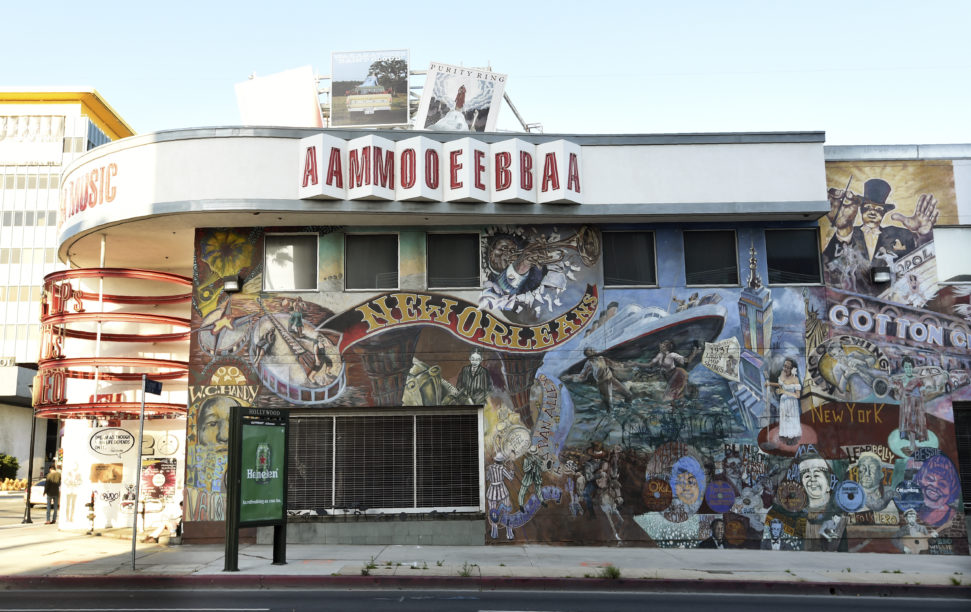
Operated by Lighthouse ArtSpace, the Immersive Van Gogh exhibit currently offers visitors to the old Amoeba space—at forty bucks a pop—the chance to meander through massive rooms blanketed with giant projections of Van Gogh’s paintings as melancholy music plays in the background.
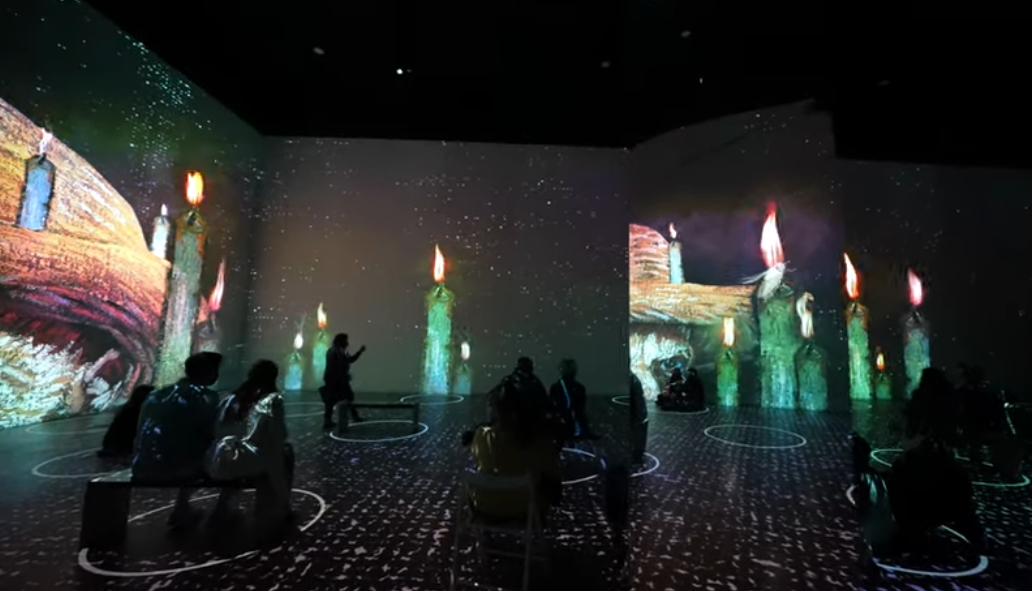 screenshot: YouTube
screenshot: YouTubeOne painting morphs into the next, from room to room; the deep darks of The Potato Eaters giving way to the waving yellows of Wheatfield With Crows, followed by the whirling blues and whites of The Starry Night. A visual dramatization of the artist’s legendary demons is threaded through the experience; the tables and chairs in the Bedroom In Arles take their shapes from etchings on a black background, presenting an image of domesticity against a backdrop of dread and fear. The arches of Corridor in the Asylum slide over one another endlessly, each corridor leads inescapably to another and another and another, giving the sensation of a never-ending flight from an inescapable prison. At the exhibition’s end, four lit candles balanced on top of his hat in a self-portrait are snuffed out, one by one. It is surprisingly moving.
“Neither the modern mass audience for art, nor the elevation of the artist as secular saint, nor the undercurrent of faith in the expiatory powers of self-sacrificial genius, really existed in 1890,” observed the critic Robert Hughes in a pointed critique of the jam-packed 1984 blockbuster Van Gogh exhibition at New York’s Metropolitan Museum. “The general public, one may predict, will see very little”—the sardine-packed viewers were bound to be hustled through “a milling scrum of backs.” A shame, Hughes concluded, because Van Gogh’s images “beg for the solitary and unharried eye to receive their energy, pathos and depth of conviction.”
The Van Gogh Immersive Experience both improves upon and debases the Met Experience of 1984. Looking at a real painting is an incalculably more rewarding proposition than looking at a reproduction, but these images are neither the real thing, nor quite a reproduction; they’re a new, hybridized way of considering a painter’s way of seeing. The Immersive Experience is designed for “the solitary and unharried eye,” which is filled to the brim with color and sensation. But the exhibit fails utterly in the matter of analysis. Four introductory placards give a vague, slapdash overview of the artist’s life, making no attempt to connect the broad facts to the character, atmosphere or meaning of his work. The Lighthouse Immersive app provides QR codes to scan for the usual biographical tidbits—youth in the Dutch countryside, time as a Christian missionary, absinthe habit, severed ear. To judge these choices charitably, we might say that the Immersive Experience is meant to be understood through feeling rather than examination.
In an interview with the Las Vegas Review Journal, Immersive Van Gogh creator Massimiliano Siccardi revealed himself as the near-opposite of an art historian. “Everyone was afraid of [Van Gogh] when he was alive,” he said. “They would say, ‘But he’s crazy!’ But that’s also exactly why everyone loves him. We recognize little pieces of Vincent and his craziness in us.” Just as he replaced the “exclusive” and rarefied atmosphere of the museum with a mega trippy slide show, Siccardi’s curatorial patter comes off as almost burlesque.
When asked about his favorite Van Gogh painting, Siccardi answered, “The portrait with the cut ear. If you look at his gaze in that work you can see he was a visionary… That’s also why Van Gogh was not famous during his life. He was so advanced that people couldn’t understand him.” Genius and madness, compressed into a $40 experience. How far is this, really, from the blockbuster experience of a big museum show? How much more artificial, effectively, how much less meaningful, thought-provoking or compelling? If paintings are images, are colors and lines that provoke ideas and understanding about the shape and texture of the world, and about human eyesight and the nature and limitations of the senses, how much less valuable is Immersive Van Gogh than a trip to the Met?
By now it’s impossible to speak of Van Gogh’s work outside the context of his madness, and like many superficial observers, the designers of this exhibit have lazily conflated the artist’s mental illness with his talent. Their portrait of Van Gogh as a lone tortured genius is as inaccurate as it is banal. He was an intensely scholarly and committed craftsman who maintained, for example, rich and meaningful (if troubled) friendships with fellow painters Émile Bernard and Paul Gaugin; he was capable as perhaps no other artist has ever been of communicating his process and his discoveries in words of extraordinary descriptive power.
Ultimately, like most things sold to us as “interactive,” these immersive animations offer viewers fundamentally passive, predetermined outcomes, rigidly shaping interpretation rather than offering opportunities for personal reflection and response. We’re given little choice but to accept the curators’ views: Van Gogh was nothing more than how he saw the world, and he saw the world as a tortured genius.
The image celebrates the cheap divide between the creative genius and the rest of us. Beauty is created only by the very special, and especially, by those in pain. The faux-populism, the recognition of “little pieces of Vincent and his craziness in us,” according to Siccardi—Van Gogh is both one of us, and beyond our comprehension.
In his entry on Van Gogh in Nineteenth Century Art: A Critical History, Stephen Eisenman wrotethat the artist’s views were typical of writers, painters and philosophers of the era in expressing “an attitude of romantic anticapitalism.” Influenced by the utopian socialism of Henri de Saint-Simon, Van Gogh saw a just future in the radical reorganization of society along egalitarian lines. His letters to his brother Theo express sympathy with strikes by miners and weavers; he was a working-class artist, struggling along with other working-class people.
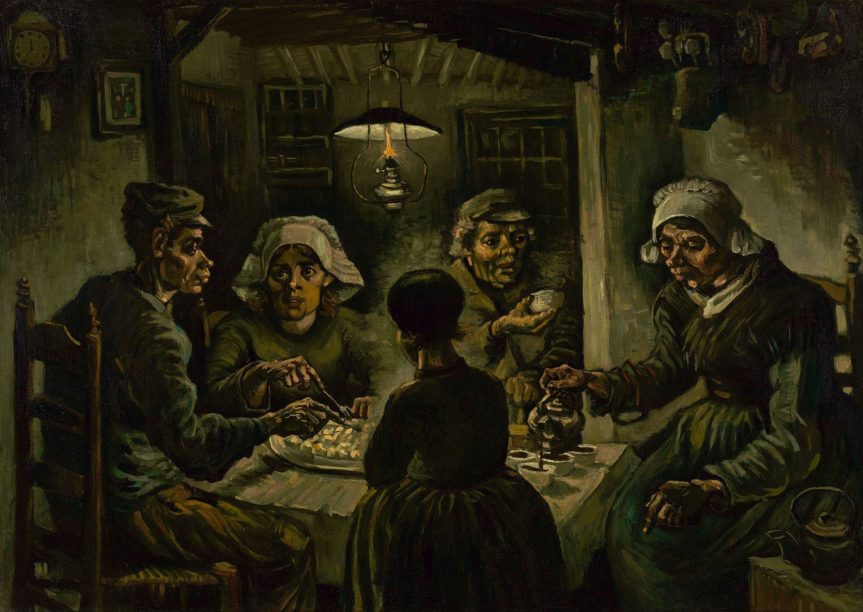
Van Gogh’s early works, such as The Potato Eaters, demonstrate a clear sympathy for working people. In the most strikingly beautiful moments of the Immersive Van Gogh exhibit, though, it’s the environment – the buildings, fields, skies – that take center stage, never the human beings, with the exception of the self-portraits. But the mature Van Gogh frequently put farm workers and other anonymous laborers front and center, as in Noon Rest and The Sower. On the few occasions these works appear in the Immersive Van Gogh, the animation pushes their human subjects to the background.
Conventional appreciations often gloss over the social changes that shaped Van Gogh’s philosophical and political beliefs. That the Immersive Van Gogh follows suit isn’t particularly surprising, but it does rob us of a wellspring of criticism, a chance to view Vincent in relation to his world, and ours in relation to his. Van Gogh’s spectacular colors don’t simply pull us into a different world; still less are they merely a symptom of his madness. Rather the colors highlight an ephemeral beauty disappearing, as industrialization sped up and atomized daily life.
The Immersive Experience, by contrast, pushes Van Gogh’s aesthetics through a filter that either waters down this romantic radicalism, reducing it to a highly individualized and passive gift-shop consumer model. The invitation to critical engagement, of reimagining the world, is lost in favor of letting the world be designed around us. The tragedyis that the media technologies, the grand animations that allow us to lose ourselves in the midst of whirling colors, operate, paradoxically, on a level of imaginative impoverishment.
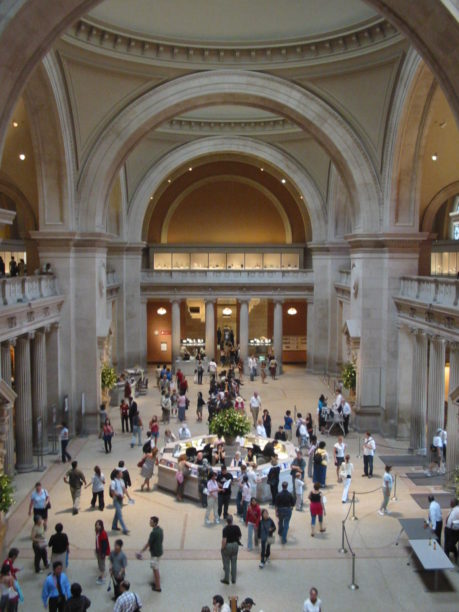
In Ways of Seeing, John Berger argued that most museum curation served to mystify rather than explain art’s function and meanings. Rather than view a painting in its social context – and our own – the museum provides access to a superior understanding, knowable only to the unique genius of the artist and, to a slightly lesser extent, to an inner circle of cognoscenti sensitive to and trained in those mysteries. The rest of us are just lucky to bask in their glow. Ultimately the Immersive Van Gogh exhibit provides a kind of mirror image of that exalted role: an everyman’s bland populism to take the place of the museum’s sublime understanding of the intricacies of art’s history and meanings—and a way for viewers to expand their own understanding beyond the interpretations on offer.






